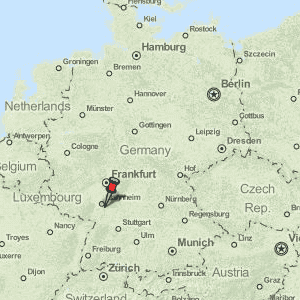In 1885, Ludwigshafen is located on the Rhine River. To the east across the river was the city of Mannheim. In 1865 the chemical company BASF made the move across the Rhine from Mannheim to Ludwigshafen. As a result, Ludwigshafen went undergoing a period of rapid growth as other chemical companies began to make Ludwigshafen home.
In 1905 the family was living in Brooklyn, New York. Unfortunately, Peter passed away in April leaving Margaretha with 6 children at home: George (22), Frank (20), Peter (16), John (13), Paulina (11) and Valentine (6).
Not long after Peters' death, on September 4, 1909 Frank married Cecelia Strahle. By 1917 their family had grown with the addition of 4 children: Margaret (1909), Frank (1911), Marie (1913), and Cecilia (1915). The world at this time was embroiled in the war to end all wars - World War I. The United States declared ware on Germany on April 2, 1917.
"At the time, these roughly eight million Americans were the country’s largest non-English-speaking group. Many had come over in a migration wave in the late 19th century...Because Germany was one of America’s adversaries in the war, many Anglo-Americans began to fear that German Americans were still loyal to the Kaiser, or German emperor. Suddenly, German Americans became “hyphenated Americans” who suspiciously practiced their own traditions instead of “assimilating” into Anglo-American culture. As President Woodrow Wilson once admonished: “Any man who carries a hyphen about with him, carries a dagger that he is ready to plunge into the vitals of this Republic when he gets ready.”...With the war, German Americans became a perceived security threat."1
"Many German Americans struggled with their feelings, realizing that sympathy for their homeland appeared to conflict with loyalty to the U.S. Some German Americans reacted by overtly defending their loyalty to the United States."2
So it is probable that although Frank had been in the United States since he was 2, that at the age of 32 and with a wife and 4 young children he felt the need to demonstrate his loyalty to the United States by completing a Declaration of Intention to become a US citizen in 1917. Part of that declaration was renouncing allegiance to Wilhelm II, Kaiser of Germany. Individuals had to wait at least 2 years after their declaration before being able to file a Petition for Naturalization. Frank filed his Petition in 1919.
Frank Hillenbrand's (L) January 30, 1917 Declaration of Intent; (R) March 18, 1919 Petition for Naturalization. Images from the digital collection of Edward Olsen.
But forever what reasons we do not know, Frank did not follow up on his 1919 Petition for Naturalization. In 1921 Frank's Petition was dismissed because "petitioner failed to prosecute." Frank either did not follow up with any additional paperwork or failed to show up for an interview.
By 1921, did Frank no longer feel the pressure to officially become a US citizen since World War I had ended 3 years earlier? Was he further settling into family life with 2 more children in his young family: George (1919) and Peter (to arrive in November 1921) and he wasn't able to find the time to complete the process?
 |
| Order of Dismissal dated May 13, 1921 for Frank Hillenbrand's 1919 Petition for Naturalization. Image from the digital collection of Edward Olsen |
In 1934 Frank again completed the Declaration of Intention, since his 1917 Declaration was only valid through 1924. In 1937 Frank completed his Petition for Naturalization.
In April 1937 in response to Frank's Petition in January, Frank signed an Oath of Allegiance renouncing the German Reich.
 |
| Frank Hillenbrand's April 23, 1937 Oath of Allegiance. Image from the digital collection of Virginia Summers Olsen. |
 |
| Frank Hillenbrand's Certificate of Citizenship (Naturalization Papers) dated April 23, 1937. Image from the digital collection of Virginia Summers Olsen. |
How I'm related to Frank Hillenbrand:
Frank J. Hillenbrand = Cecelia A. Strahle
Frank J. Hillenbrand = Cecelia A. Strahle
|
Clifford Olsen = Emma Hillenbrand Olsen
|
Dad = Mom
|
Me
References:
1 https://www.history.com/news/anti-german-sentiment-wwi
2 https://www.loc.gov/teachers/classroommaterials/presentationsandactivities/presentations/immigration/german8.html
3 https://history.howstuffworks.com/world-war-ii/buildup-to-world-war-23.htm
https://en.wikipedia.org/wiki/Ludwigshafen
https://www.freecountrymaps.com/map/towns/germany/240125892/
https://www.uscis.gov/ilink/docView/AFM/HTML/AFM/0-0-0-1/0-0-0-1067/0-0-0-2008.html?fbclid=IwAR0okkALxkZ_vFTEggYelE6uvRhW7amu-RNAe9QNoOoYtJhYX5Dt3BchVqc





